Over the next couple of weeks we’ll be changing the address of Now Read This, so please update your links, bookmarks and Favourites to point to:
www.comicsreview.co.uk/nowreadthis
Hope to see you there!
W!n and the Gang

Graphic Novel Reviews and Recommendations by WIN WIACEK
Over the next couple of weeks we’ll be changing the address of Now Read This, so please update your links, bookmarks and Favourites to point to:
www.comicsreview.co.uk/nowreadthis
Hope to see you there!
W!n and the Gang
A MARVEL GRAPHIC NOVEL
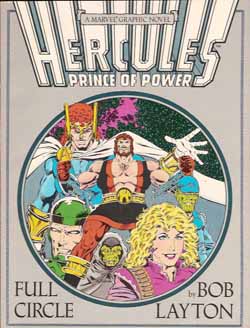
By Bob Layton, with John Workman & George Roussos (Marvel)
ISBN: 0- 87135-397-0
One of Marvel’s earliest miniseries successes was an “out of continuity†saga featuring Greek demigod and occasional Mighty Avenger Hercules in a lighthearted action romp across the universe of the future. Carousing and combat were the order of the day (see Hercules, Prince of Power ISBN-13: 978-0-78510-555-8) and with comedy comrades the Rigellian Recorder (a po-faced, sentient robot programmed to acquire all knowledge) and a cheap ‘n’ sleazy Skrull named Skyppi, he had a fine old time until Zeus called him home to take over the family business. As the only remaining Olympian god on our plane of reality he was charged with settling down and creating his own pantheon…
Thirty years later on the planet Wilamean in the Andromeda Galaxy a supremely powerful dictator named Arimathes is Emperor of a rapidly expanding, aggressive interstellar nation. Incredibly strong, and boiling with indignant rage, he is hunting for the deadbeat dad who abused his mother and disappeared into the void…
Closing out this future saga was never going to be an easy task and this competent thriller sadly falls a little short of the mark set by its boisterous, exuberant predecessors. The laughs are fewer and seem a little forced when Hercules is put in the position of responsible adult, but the action is spectacular and the subplot of the Prince of Power’s one time paramour as embittered, spiteful Queen Mother adds some welcome balance and consequence to the immortal’s “love ’em and leave ’em†serial dalliances.
Less fun, more considerate but still full of mirth and mayhem, this is a solid end to a saga from an industry that doesn’t often do “closureâ€. Produced in the oversized 285 x 220 mm (rather than the now customary 258 x 168 mm) format this big story is – warts and all – still a big, enjoyable read well worth tracking down; and who knows, perhaps one day American publishers will revive the large-page format for our edification and their profit.
© 1988 Marvel Entertainment Group/Marvel Characters, Inc. All Rights Reserved.
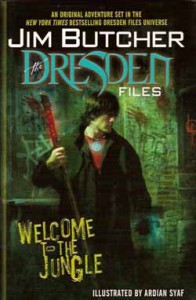
By Jim Butcher & Ardian Syaf (Titan Books/Dabel Brothers Publishing)
ISBN: 978-1-84856-208-0
Jim Butcher is a best-selling novelist and comics fan whose tales of a wizard-for-hire on the mean streets of modern Chicago have won him legions of fans, and even spawned a short-lived but excellent TV series.
In this tale set just before the first novel, Storm Front, Harry Dresden is an “unconventional†Private Eye who occasionally consults for the Chicago Police Department’s Special Investigations Unit, walking a fine line as a specialist fighting supernatural menaces whilst trying to keep all things mystical a secret from the unsuspecting public.
When a Zoo keeper is torn to shreds he uncovers a plot by an ancient horror that will have catastrophic repercussions for frail humanity…
Exceedingly readable, the premise may not be fresh to fantasy fans but the characters and dialogue are top-rate and the art from Ardian Syaf and inkers Nick Nix, Joe Pimentel, David Rivera and Rick Ketcham is understated and highly effective.
This lush hardcover comes with a cover gallery, production sketches plus character studies and profiles. As well as being a great piece of comics storytelling, this book will hopefully entice a few more hold-outs into our magical world of pictures and words. A potential seasonal gift for your favourite comics-resister, perhaps..?
© 1997, 1998 DC Comics. All Rights Reserved.
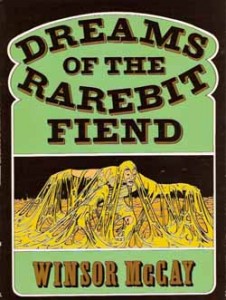
By Winsor McCay (Dover)
ISBN: 0-486-21347-1 ISBN-13: 978-0486213477
Born in Spring Lake, Michigan, on 26th September, 1869 (or perhaps 1871- records differ) Winsor McCay was a brilliant and hugely successful cartoonist and animator who worked on strips and political cartoons from 1903 until his untimely death in 1934. The first of these was Jungle Imps (1903), for The Enquirer, before moving to New York and creating Dull Care, Poor Jake, The Man from Montclair, The Faithful Employee, Mr. Bosh, A Pilgrim’s Progress, Midsummer Daydreams and It’s Nice to be Married for New York Herald publisher James Gordon Bennett between1903 and 1911.
He also originated Little Sammy Sneeze for the Herald in 1904 and Hungry Henrietta in 1905 before abandoning them for two much more important features. On October 15th 1905 the most important children’s strip in the world, Little Nemo in Slumberland, debuted in the Sunday Herald, but even before that McCay had created a version for adults entitled Dreams of the Rarebit Fiend for The Evening Telegram. The editor, wishing to distance the feature from other strips, asked McCay to use a pen-name, and he complied, signing the strips “Silasâ€, reputedly after a local garbage cart driver.
Where Nemo was a beautifully clean and surreal fantasy of childish imagination, Fiend was aimed at grown-ups and displayed a creepy, subdued tension that resonated with the fears and worries of its audience. Black, cruel and often outright sick humour pervades the series. Even the root cause of the otherworldly nightmares was salutary. Each self-contained episode, every disturbing sequence of unsettling or terrifying, incredibly realistic images was the result of overindulgence; usually in late night toasted cheese treats!
Every anxiety from surreal terror to social embarrassment became grist for the fantasist’s mill and the startling perspectives, bizarre transformations and uncanny scenes – always immaculately rendered – made Fiend a hugely successful and well regarded strip in its day.
In 1906 the American film pioneer Edwin S. Porter created a landmark seven minute live action special-effects movie entitled The Dream of a Rarebit Fiend and the Edison company created a cylinder recording with the same name the following year – played by the Edison Military Band. McCay himself produced four animated films in 1916-17: Dream of a Rarebit Fiend, Dreams of the Rarebit Fiend: The Pet, Dreams of the Rarebit Fiend: The Flying House and Dreams of the Rarebit Fiend: Bug Vaudeville.
This book is an almost exact reproduction of Rarebit Fiend, a collection of the first year’s strips originally released by the Frederick A. Stokes Company in 1905. The very last strip has been excluded from this edition however, due to its content being potentially offensive and at odds with modern views on race and ethnicity.
Although working more than a century ago Winsor McCay still affects every aspect of graphic narrative produced ever since. If you can’t afford Ulrich Merkl’s superb complete edition, reprinting everything from 1905-1914, this lovely package – still readily available from internet retailers – is a superb introduction to the darker side of an absolute master of our Art-form.
© 1973 by Dover Publications, Inc. All Rights Reserved.
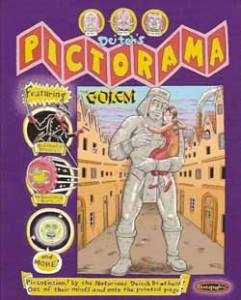
By the Deitch Brothers (Fantagraphics)
ISBN: 978-1-56097952-4
There must be something to this DNA stuff. Gene Deitch is an Oscar winning animator and cartoonist, his first son Kim has been at the forefront of comics’ avant-garde since the days of the Counter Culture and “underground commix†scene whilst his other two, Simon and Seth Kallen, have both made their mark in the popular creative arts.
In this bold new venture the Deitch boys have created a graphic narrative oddity that is both compelling and captivating. Combining heavily illustrated prose, comics, calligraphy, pictorial lettering, cartooning and plain old strips, the five tales blend into a tribute to the versatility of illustrated storytelling in all its variations.
Beginning with a captivating paean to bottle caps and the collecting bug entitled ‘the Sunshine Girl’, followed by an intriguing prose-ish fantasy, ‘The Golem’, the full range of tale-telling is explored. This leads into the disturbing ‘Unlikely Hours’, and a whimsical shaggy dog story ‘Children of Aruf’.
Wisely leaving the very best ’til last, the Pictofictorial fun concludes with the superbly engaging and informative ‘The Cop on the Beat, the Man in the Moon and Me’; an especial treat for anybody interested in the history of comics and music.
Once again I’ve been as vague as I can be, because this is a book that rejoices in storytelling, and half the art and all the joy comes from reading it for yourself, so if you’re an older reader you should do just that.
© 2008 Gene, Kim, Seth Kallen and Simon Deitch. All Rights Reserved.
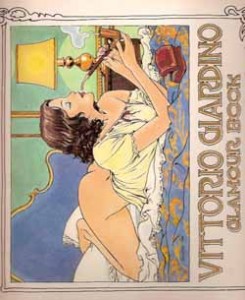
Edited by Vincenzo Mollica & Antonio Vianovi (Glamour International Productions)
No ISBN
Born on Christmas Eve 1946, Italian electrician Vittorio Giardino changed careers at age 30. Working for many European comics magazines initially, his first collection, Pax Romana, was released in 1978. He has worked slowly but consistently on characters like detective Sam Pezzo, saucy Winsor McKay homage Little Ego, the cold-war drama Jonas Fink and diffident super-spy Max Fridman as well as general fiction tales, producing over 35 albums to date.
In 1986 the Italian outfit which produced the stylish Popular Arts magazine Glamour Illustrated released a number of fabulous art-books collecting the works of some of the biggest names in European narrative storytelling, which had limited distribution in Britain thanks to the specialist importer Titan Distributors, and this is probably the very best of them.
This glorious 200 page tome (48 of them a full-colour high-gloss insert) simultaneously translated into French and English, displays the incredible ability and versatility of an incomparable creator, with excepts from printed works, extensive sketch and working drawing sections a full publication record to date, notes and an appreciation by Gianni Brunoro.
As you would expect there is a large amount of beautifully drawn flesh on display, as well as some of the most clean and sublime narrative art produced in the last half century. Extended excerpted sequences from Sam Pezzo, Little Ego, and Max Fridman show Giardino’s unique ability to inform and suggest with nuanced expression and gesture, and his scrupulous devotion to research and historical accuracy whilst his straight cartooning reveals a sly, dry sense of humour.
This is beautiful book desperately in need of updating and re-release, and Giardino is a world class storyteller that English speakers have too long been deprived of…
No copyright notice so let’s assume © 1976-1986 Vittorio Giardino. All Rights Reserved. If anybody knows better please let me know and we’ll amend the entry.
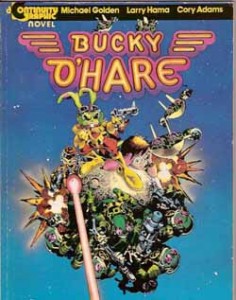
By Larry Hama, Michael Golden & Cory Adams (Continuity Publishing)
No ISBN: ASIN: B000E4SUCM
In the darkest depths of another kind of cosmos justice is upheld and right enforced by agents of S.P.A.C.E (Sentient Protoplasm Against Colonial Encroachment): the police arm of the United Animal Federation. The mammals of this Aniverse are at war with the amphibians of the Toad Empire, and their evil overlord the computer tyrant Komplex.
When a running battle forces the S.P.A.C.E Frigate Righteous Indignation to crack the walls of the continuum, captain Bucky O’Hare, Jenny the Cat, android Blinky, and Deadeye the four-armed duck end up in little Willie DuWitt’s closet in San Francisco. The ingenious Grade Schooler helps out the refugees from beyond, but is subsequently trapped in the Aniverse, becoming a crew member until they can find another portal to his home.
But meanwhile Willie’s got front row seats for the greatest adventure in two universes!
This fabulously cool and charming light-adventure began as serial segments in Neal Adam’s Continuity Comics anthology Echoes of Futurepast, before being collected into a great all-ages album, and for a brief moment was the toast of kids entertainment, spawning an animated TV series (1991-1992), computer games and action figures and toys, and a British company (DC Thomson if I remember aright) picked up the UK rights, publishing a dozen or so all-new adventures after reprinting the Larry Hama/Michael Golden mini masterpiece.
In 2007, Vanguard reprinted the original graphic novel and a couple of the UK issues in a manga format, black-and-white book collection, called ‘Bucky O’Hare and the Toad Menace’ (ISBN-13: 978-1-88759-196-6) but as both the hardcover and paperback originals from 1986 are still readily available and sparkle with Cory Adams’ vibrant, contagious colours, I’d advise you hunt either of those down as Golden’s incredible artwork is a tad to busy at the reduced size.
Hama reputedly wrote a second complete Bucky O’Hare tale which has never been published, so if I can do my bit to create an atmosphere where he can, maybe I can win a MMM (Muddled Mammal Medal) for services to Great Fun…
© 1986 Continuity Graphics Associates, Inc. All Rights Reserved.
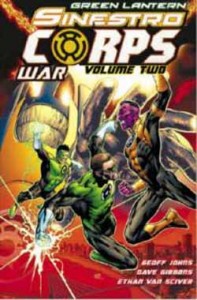
By Geoff Johns & various (DC Comics)
ISBN13: ISBN13: 978-1-4012-1800-3
The universe-shaking battle between absolute security and total terror crashes to a stupendous climax with Earth as the prize and final battleground. The renegade Green Lantern Sinestro has declared war on the entire cosmos and his legions of eager brutalists are carving a bloody swathe through civilised worlds and peacekeepers alike aided by his evil lieutenants Superman-Prime, the Manhunters, Mongul, Cyborg Superman and the Anti-Monitor, and especially the very embodiment of fear: Parallax.
Reduced to a desperate last stand the Green Lanterns unite with the heroes of Earth to snatch a victory of sorts from the jaws of defeat in a action-packed, visually mind-blowing blockbuster which is only the portent of greater dramas to come…
This concluding volume collects Green Lantern #24-25 and Green Lantern Corps #16-19 written by Geoff Johns, Dave Gibbons and Peter J. Tomasi, illustrated by Ethan Van Sciver, Ivan Reis, Patrick Gleason, Jamal Igle, Jerry Ordway, Angel Unzueta, Oclair Albert, Pascal Alixe, Dustin Nguyen, Vincente Cifuentes, Rodney Ramos, Rob Hunter, Marlo Alquiza, Rod Reis, Prentis Rollins, Julio Ferreira, Derek Fridolfs, Dan Davis Rebecca Buchman. Tom Nguyen, Drew Geraci, with colour from Moose Bauman, David Curiel, JD Smith and Guy Major.
Also included is an extensive commentary section, stuffed with production art. A pictorial feast, this book is best read in close conjunction with volume 1 (ISBN13: 978-1-4012-1650-4) and the ancillary Green Lantern: Tales of the Sinestro Corps (ISBN13: 978-1-4012-1801-0).
© 2007 DC Comics. All Rights Reserved.
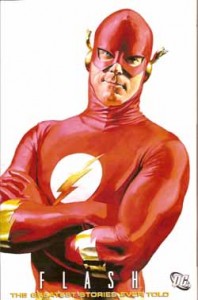
ISBN: 978-1-4012-1372-5
The Greatest Stories series of collections has thrown up some unexpected treats in its selection of material, so kudos to all the researchers and editors involved. This volume presents some genuinely intriguing choices featuring three of the characters DC has featured as “the Fastest Man Aliveâ€.
From the Golden Age come two classics of Jay Garrick – a scientist exposed to “hard water fumes†which gave him his super-speed and endurance. Both written by Robert Kanigher, the first, ‘Stone Age Menace’ (Flash Comics #86, 1947) is illustrated by Lee Elias and Joe Kubert and has the irresistible enticements of gangsters and dinosaurs, whilst the much reprinted ‘The Rival Flash’ was the last published tale of the first speedster with the bonus of recapping his origins whilst tackling a villain with all his powers. The art was by Carmine Infantino and Frank Giacoia – who would both work wonders with the Silver Age revival – and originally appeared in Flash Comics #104, 1940.
For nearly a decade, licensed properties, Westerns, War, Mystery and other genre fare dominated the newsstands and despite the odd sally, costumed heroes barely held their own until Julius Schwartz ushered in a new age of brightly clad mystery-men by reviving the Flash in 1956.
For the great majority of fans (aging baby-boomers that they are) police scientist Barry Allen will always be the “real†Scarlet Speedster, struck by lightning, bathed in chemicals – if you couldn’t find an atomic blast to survive, that kind of freak accident was the only way to start a career. From his spectacular run comes the absolute landmark which marked the beginning of a way of life for do many addicted kids.
‘Flash of Two Worlds’ by Gardner Fox, Carmine Infantino and Joe Giella (Flash #123, 1961) revived the Golden Age Flash, and by implication, the whole 1940s DC pantheon, by introducing the concept of parallel worlds and multiple Earths which became the bedrock of the entire continuity, and which the company still mines to such great effect. What’s seldom mentioned is that this initial meeting between the two Flashes is a great super-villain romp featuring a perfect pitched battle against three truly eerie foes: The Fiddler, the Thinker and the Shade.
Villain team-ups were increasingly a major part of the comics experience. Stacking the odds always increased the tension for the thrill-hungry reader and ‘The Gauntlet of Super-Villains!’ by John Broome, Infantino and Giella (Flash #155, 1965) which pits the Vizier of Velocity (don’t you just love those cool alliterative appellatives?) against Mirror Master, Captains Boomerang and Cold, Heatwave, Pied Piper and the Top is one of the best ever, stuffed with action, whimsy and sly wit, and with a hidden mystery foe to crank up the element of danger even more.
Flash #165 (1966) by the same creative team featured another kind of landmark as Barry finally married his long-time fiancée Iris West in ‘One Bridegroom Too Many!’, a shocking thriller wherein his evil counterpart Professor Zoom, the Reverse Flash, attempted to replace him at the altar. Fast-paced and totally captivating the tale also posed a Gordian puzzle for Barry. Should he reveal his secret identity to Iris – who had no idea she was marrying a superhero – or say nothing and pray she never, ever found out?
Every married man already knows the answer* but for us kids reading this the first time around that question was real stumper.
When Carmine Infantino left the strip most fans were convinced the Flash was ruined. Replacement art team Ross Andru and Mike Esposito were highly controversial and suffered most unfairly in unjust comparisons – and I count myself among their biggest detractors at the time – but in the intervening years I’ve leaned to appreciate the superb quality of their work.
Their tenure is represented here by ‘The Flash – Fact of Fiction?’ from Flash #179 (1968). Written by newcomer Cary Bates and Gardner Fox it took the multiple Earths concept to its logical conclusion by trapping the Monarch of Motion in “our†Reality, where the Flash was just a comic-book character!
Bates eventually became the regular writer of the series and in 1978, when the industry was at its lowest commercial point, wrote the longest single adventure in the Flash’s history. Desperately trying new formats the company launched DC Special Series, a extra-long format for non-standard material. Issue #11 was a 63 page Flash Spectacular which featured Jay Garrick and fellow 1940s speedster Johnny Quick, Barry Allen and the sidekick speedster Kid Flash in a Sci Fi extravaganza ‘Beyond the Super-Speed Barrier!’
Broken into six chapters it featured art from Irv Novick and Alex Savuik inked by Joe Giella, plus Kurt Schaffenberger and Murphy Anderson illustrating the Golden Age Hero chapter and the dream team of José Luis GarcÃa-López inked by Wally Wood on the Kid Flash section. What more could any art fan want?
Barry Allen died during the Crisis on Infinite Earths (ISBN13: 978-1-5638-9750-4) – whatever that means in comics – and his nephew Wally West graduated from sidekick to the third Sultan of Speed. From Flash volume 2, #91(1994) comes ‘Out of Time’ to close the book. Writer Mark Waid and the much-missed Mike Wieringo (inked here by Jose Marzan Jr.) utterly revitalised the character in the 1990s and this snappy, stylish tale of impossible circumstances clearly shows why and how.
Not quite an icon like Superman, Batman or Wonder Woman, the Flash is nevertheless the quintessential superhero and the reason we’re all doing this today. This book is a great example of why and readily accessible to nostalgists and neophytes alike. Whatever your age there’s something great here for you to enjoy and treasure.
*In case you’re not married, or not a man, the answer is: Fake your own death and move to Bolivia. And if you find a woman there, always tell her everything before she asks or finds out.
© 1947, 1949, 1961, 1965, 1966, 1968, 1978, 1994, 2007, DC Comics. All Rights Reserved.
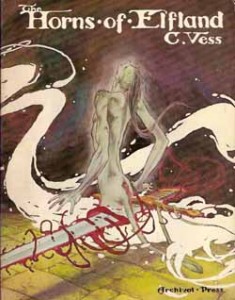
By Charles Vess (Archival Press)
ISBN: 0-915822-25-3
The Comics Arts movement was in its infancy in the mid 1970s and it’s through the efforts of such folk as the Archival Press on one hand and the likes of Ken Pierce on the other that the works of our industry were gradually legitimised into the budding art-form we all aspire to – sadly, a process still not completed in most English speaking countries.
From 1979 then comes this lovely compendium of the early works of Charles Vess, fantasist, supreme stylist and champion of the craft of the illustrator. In bold, dynamic, beguiling black and white this entrancing collection of prose vignettes and comic strip displays his love of the form and his striking ability with pen and brush, as well as his wry and gentle sense of humour.
‘The Shadow Witch’ is a gloriously baroque fairytale copiously illustrated with fine pen (or maybe quill!) work that is wonderfully balanced by the fantasy adventure strip ‘Demon Sword’ whilst the lyrical whimsy of ‘the Fiddler and the Swan’ shows the deep regard the artist has for the Victorian and Edwardian illustrators such as Arthur Rackham.
Vess’ modern works are a highpoint of the form and along with Kaluta and Gary Gianni form the last bastion of a classical revivalist style lost in the rush to modern techniques and technology. These examples of the power of the ink line should be mandatory viewing for any aspiring artist, and the easy skill with which these stories are told make them compelling beyond belief. Let’s have a definitive collection now!
© 1979 Archival Press, Inc. Stories © 1974, 1979 Charles Vess. All Rights Reserved.